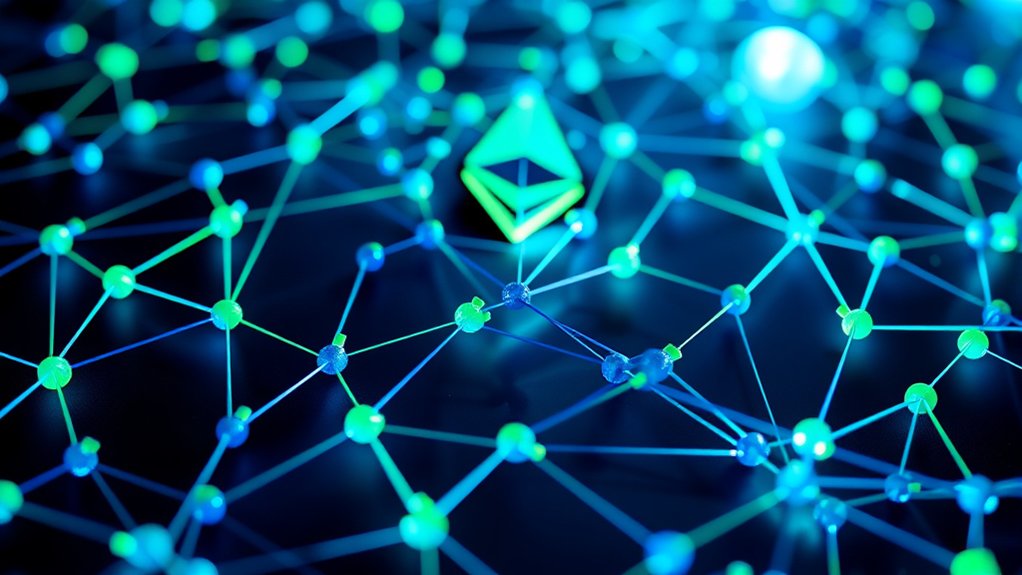Polygon, once the Matic Network, is a Layer 2 scaling powerhouse for Ethereum. Think of it as a turbo boost—faster transactions and smaller fees. It’s built with a mix of fancy tech like PoS and various rollups, offering flexibility and high throughput. Developers love it, and gamers do too, thanks to quick swaps and lending. It’s pretty essential for rising dApps within Ethereum’s ecosystem. Stick around to uncover just how it’s changing the game.

When it comes to Ethereum scaling, Polygon is the name that keeps popping up. Formerly known as the Matic Network (because who doesn’t love a good rebrand?), Polygon is a Layer 2 scaling solution aimed at turbocharging Ethereum’s performance. Think of it as the much-needed booster shot for Ethereum. Its primary mission? To deliver high-speed, high-throughput, and low-cost transactions. Sounds dreamy, right?
Polygon is the Layer 2 powerhouse transforming Ethereum with blazing fast, cost-effective transactions—like a booster shot for blockchain!
Polygon doesn’t just stop there. The architecture is modular, meaning it can play around with different scaling solutions like it’s a kid in a candy store. With core components like the Polygon SDK, Plasma Chains, ZK-Rollups, and Optimistic Rollups, it’s like a Swiss Army knife for blockchain developers. Layer 2 networks enhance scalability by offloading transaction processing, making Polygon even more effective.
And let’s not forget about its Proof-of-Stake (PoS) mechanism, which is key for keeping sidechains secure. Fast transactions? Check. Low fees? Check. Flexibility? Double check. This Proof-of-Stake (PoS) mechanism not only enhances security but also promotes decentralization by allowing wider validator participation. Additionally, Polygon’s vision of creating a network of scaling solutions ensures that it remains adaptable to the evolving needs of the Ethereum ecosystem.
In the Ethereum ecosystem, Polygon is a game-changer. It’s the shiny new toy that attracts decentralized applications (dApps) with its performance and cost-effectiveness. With the potential to handle millions of transactions per second, it’s like Ethereum’s overachieving little sibling. Security? Polygon maintains a level of safety that rivals the Ethereum mainchain, making it a popular choice for developers.
Plus, it fills the efficiency gap as Ethereum evolves to 2.0. Polygon isn’t just tech jargon—it has real-world applications. In the domain of Decentralized Finance (DeFi), it’s powering high-speed lending and swaps. Gamers love it for quick transactions.
And let’s not overlook its aim for cross-chain interoperability. Micro-payments? Absolutely! With low fees and speedy processing, it’s perfect for that.
Frequently Asked Questions
How Does Polygon Differ From Other Ethereum Layer 2 Solutions?
Polygon stands out from other Ethereum Layer 2 solutions like a peacock in a pigeon coop.
Its modular design mixes sidechains, Plasma, and zkEVM, giving it serious scalability chops. Plus, it’s all about interoperability, letting different chains chat like old friends.
Security? Tied to Ethereum for finality.
And let’s not forget the community support—developers love it. Fast and cheap transactions make it the shiny toy everyone wants to play with, while others lag behind.
What Cryptocurrencies Can Be Used on the Polygon Network?
On the Polygon network, users can dabble in a variety of cryptocurrencies.
There’s MATIC, the star of the show, handling fees and governance. Then, you’ve got ERC20 tokens galore, like WBTC and Binance-Peg BUSD.
DEX tokens? QuickSwap and Curve DAO Token are solid choices.
Don’t forget governance tokens, like MATIC again, and some project-specific ones.
It’s a crypto buffet, but good luck keeping track of it all!
Is Polygon a Decentralized Platform?
Is Polygon decentralized? Absolutely.
It’s like a digital democracy, minus the annoying debates. Validators keep the network secure through a Proof-of-Stake system, while users stake their MATIC tokens for rewards.
Forget about the big boss—there’s no central authority here. Plus, it’s Ethereum-compatible, so it rides the main chain’s security.
With a focus on community governance and no single point of failure, Polygon is as decentralized as it gets.
How Do I Buy MATIC Tokens for Polygon?
Buying MATIC tokens isn’t rocket science.
First, sign up on an exchange like Kraken or Coinbase. Yeah, they want your ID—welcome to the world of crypto.
Then, add your payment method. Pick Polygon as your asset, decide how much MATIC you want, and confirm the deal. Easy, right?
Just remember, prices can swing like a pendulum. So, don’t get too attached to your purchase amount.
Happy trading!
What Are the Potential Risks of Using Polygon?
Using Polygon comes with its fair share of risks, no doubt.
Think bridged assets—hackers love those vulnerabilities.
Then there’s the centralized Security Council. If they go rogue, good luck.
Network outages? Yup, they happen.
Plus, software bugs in shiny new tech like zkEVM can bite back.
Don’t forget about the unpredictable market and regulatory mess.
It’s a wild ride, folks. Buckle up or maybe just sit this one out.





